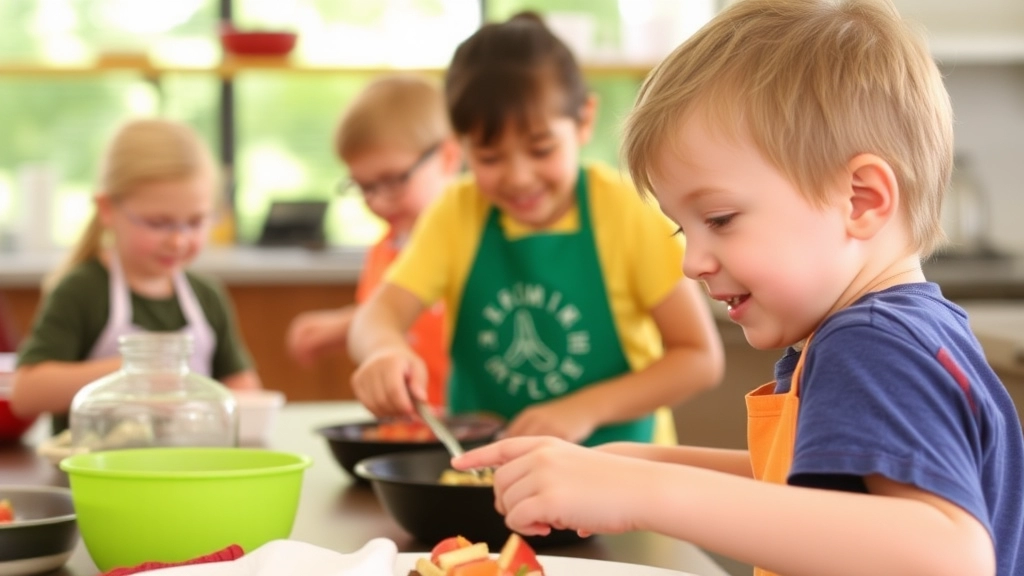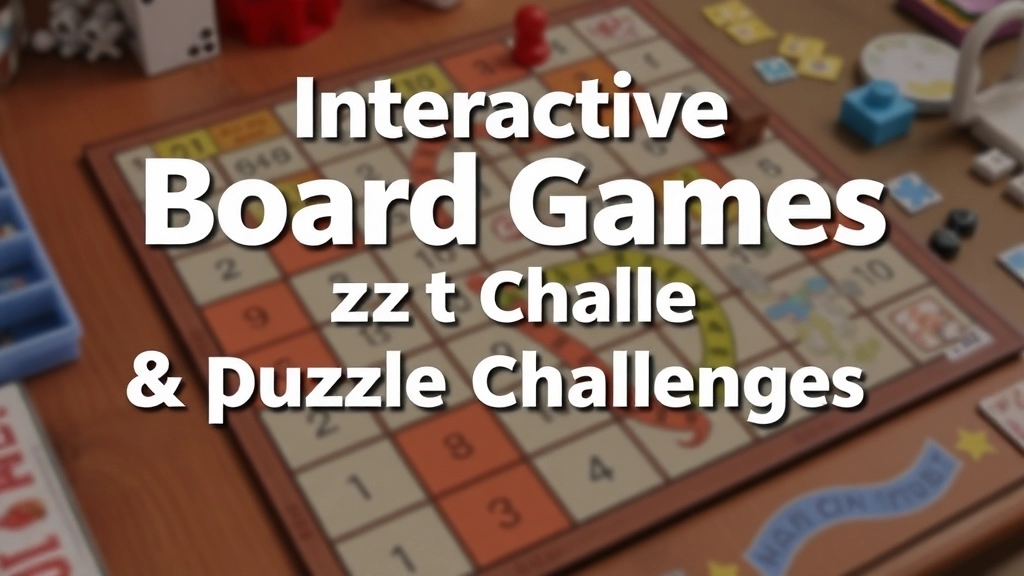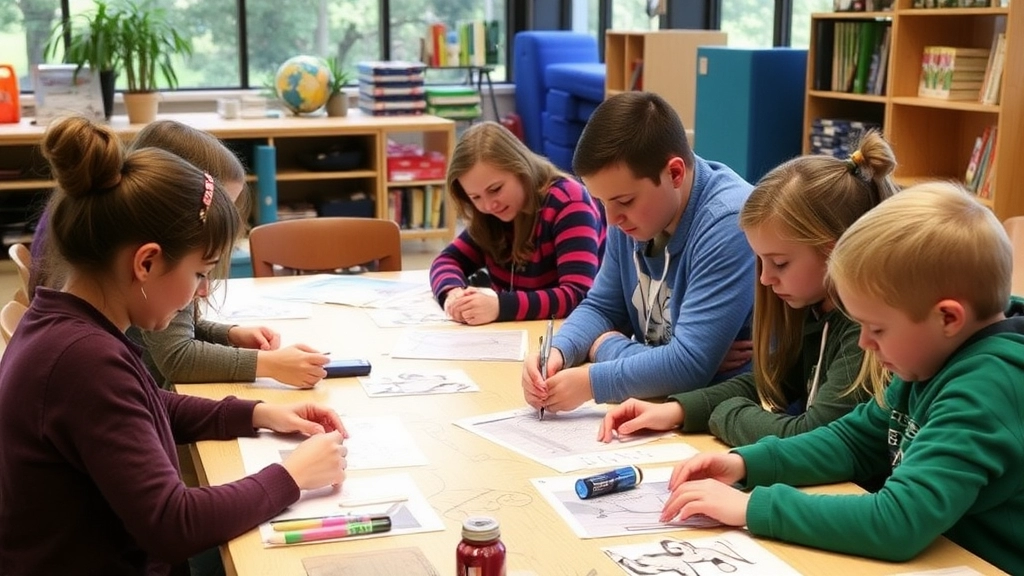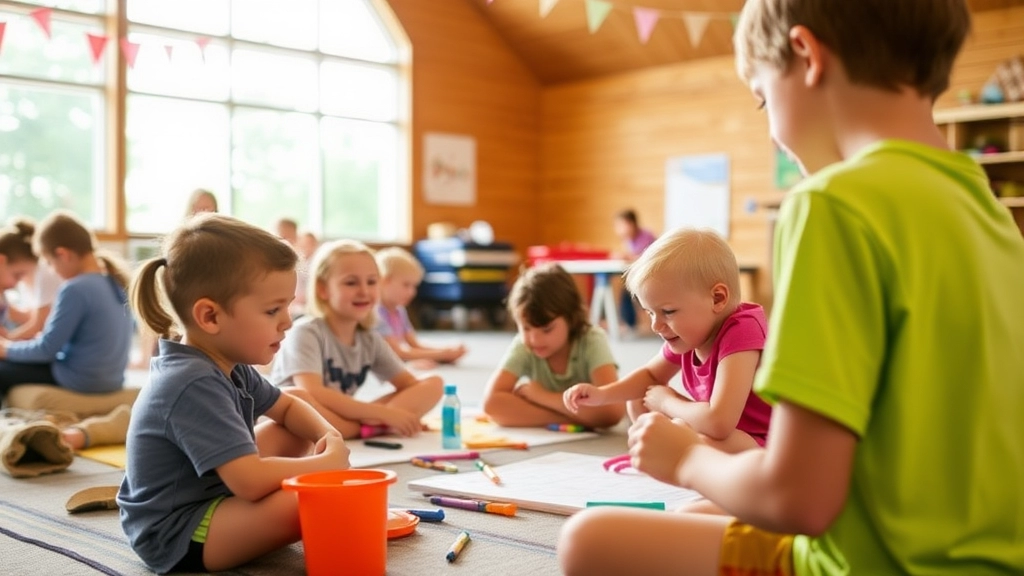Indoor Summer Camp Activities for Kids
Ever wondered how to keep kids entertained and engaged during indoor summer camps? Look no further! This article dives into a plethora of activities that will not only keep the little ones busy but also foster creativity, teamwork, and learning. From creative arts and crafts to engaging indoor games, hands-on science experiments, and even cooking classes, we’ve got you covered.
Discover how skits and drama can bring out the performer in every camper, explore the world of interactive board games and puzzle challenges, and learn how to set up your own DIY indoor escape room and scavenger hunts. We also delve into educational workshops that make learning fun and team-building games that strengthen bonds. Finally, storytelling and group discussions offer a relaxing yet engaging way to wind down. Dive in and make your summer camp indoor activities unforgettable!
Creative Arts and Crafts Activities for Indoor Camps
Ever wondered how to keep kids entertained and engaged during indoor camps? Creative arts and crafts activities are your answer. They provide a fantastic way for kids to express themselves, learn new skills, and, most importantly, have a blast. Let’s dive into some easy, fun, and engaging arts and crafts ideas that will make your indoor camp unforgettable.
Why Arts and Crafts?
First off, why should you even consider arts and crafts? Here are a few reasons:
- Promotes Creativity: Kids get to use their imagination and come up with unique creations.
- Develops Fine Motor Skills: Cutting, gluing, and painting help improve hand-eye coordination.
- Encourages Problem-Solving: Figuring out how to make something work can be a fun challenge.
- Boosts Confidence: Completing a project gives kids a sense of accomplishment.
Easy Arts and Crafts Ideas
Paper Plate Animals
Start with something simple yet effective. All you need are paper plates, markers, glue, and some craft paper. Kids can create their favourite animals, giving each one a personal twist.
DIY Friendship Bracelets
Who doesn’t love a good friendship bracelet? With some colourful threads and beads, kids can make bracelets for themselves and their friends. It’s a great way to teach them about patterns and sequences.
Painted Rocks
This one is a hit. Grab some smooth rocks, acrylic paints, and brushes. Kids can paint whatever they like, from funny faces to intricate designs. These can be used as paperweights or garden decorations.
Collage Making
Provide magazines, scissors, glue, and large sheets of paper. Let the kids cut out pictures and words to create a collage. This activity can be themed, like “My Dream Vacation” or “Favourite Animals.”
Clay Modelling
Clay is incredibly versatile. Whether it’s store-bought clay or homemade playdough, kids can spend hours moulding and shaping it into various forms. You can even have a ‘clay contest’ with different themes.
Pro Tips for Successful Arts and Crafts Sessions
- Keep It Simple: Choose activities that are easy to set up and clean up.
- Prepare in Advance: Have all materials ready before the session starts.
- Offer Guidance, Not Control: Let the kids take the lead. Your role is to guide and encourage.
- Create a Display Area: Dedicate a space where kids can showcase their creations. This boosts their confidence and makes them feel proud of their work.
Real Stories, Real Fun
I remember one indoor camp where we decided to have a ‘Nature Art’ day. We collected leaves, twigs, and flowers during a short walk and then used them to create beautiful nature collages. The kids were thrilled to see their pieces come to life, and it was a great way to blend outdoor and indoor activities.
Another time, we had a ‘Superhero Mask’ making session. Each child designed their own superhero mask using felt, glue, and markers. By the end of the day, we had a room full of mini superheroes running around, each with their unique powers and stories.
For more tips on organizing a memorable camp experience, check out our top tips for summer camp field trips and explore the best summer camp games and activities to keep the fun going!
Engaging Indoor Games for All Age Groups

Ever been stuck indoors with a bunch of restless kids or teens?
Yeah, me too.
Let’s dive into some engaging indoor games that’ll keep everyone entertained, no matter their age.
Why Indoor Games Matter
When the weather’s rubbish or you’re stuck inside, indoor games can save the day.
They keep the energy up and boredom down.
And trust me, you don’t need fancy equipment.
Classic Indoor Games
1. Musical Chairs
- Easy setup.
- Just need chairs and music.
- Fun for all ages.
2. Charades
- No props needed.
- Great for creativity.
- Hilarious moments guaranteed.
3. Simon Says
- Perfect for younger kids.
- Helps with listening skills.
- Can be as silly or serious as you want.
Group Games for Teens and Adults
1. Mafia
- Involves strategy.
- Encourages communication.
- Great for larger groups.
2. Werewolf
- Similar to Mafia.
- Adds a bit of mystery.
- Keeps everyone on their toes.
3. Pictionary
- Get a whiteboard or paper.
- Split into teams.
- Draw and guess – simple and fun.
Solo Indoor Games
Sometimes, you need games that don’t require a crowd.
1. Solitaire
- Classic card game.
- Helps pass the time.
- Great for all ages.
2. Sudoku
- Brain teaser.
- Keeps the mind sharp.
- Available in books or online.
3. Jigsaw Puzzles
- Can be a solo or group activity.
- Varying difficulty levels.
- Great for focus and relaxation.
Digital Indoor Games
In today’s tech-savvy world, digital games can be just as engaging.
1. Jackbox Games
- Play on your phone.
- Hilarious and interactive.
- Perfect for family and friends.
2. Online Trivia
- Test your knowledge.
- Compete with friends.
- Endless categories to choose from.
3. Virtual Escape Rooms
- Solve puzzles online.
- Work as a team.
- Feels like a real escape room.
Tips for Hosting Indoor Games
- Know Your Audience: Tailor the games to the age group.
- Keep It Simple: Don’t overcomplicate the rules.
- Mix It Up: Variety keeps things interesting.
- Engage Everyone: Make sure no one feels left out.
Hands-On Science Experiments for Kids Indoors
Ever been stuck indoors with a bunch of kids and wondered how to keep them entertained without resorting to endless screen time? Hands-on science experiments are your golden ticket. These activities are not just fun but also educational, sparking curiosity and a love for learning. Let’s dive into some easy-to-do science experiments that will keep the kids engaged and learning.
Why Hands-On Science?
First off, why even bother with science experiments? Here’s the deal:
- Interactive Learning: Kids learn best when they’re actively involved. Hands-on experiments make abstract concepts tangible.
- Critical Thinking: These activities promote problem-solving and critical thinking skills.
- Fun Factor: Let’s be real, watching a volcano erupt is way cooler than reading about it.
Simple and Fun Science Experiments
Alright, let’s get to the good stuff. Here are some science experiments that are easy to set up and guaranteed to wow the kids.
Baking Soda and Vinegar Volcano
This classic never gets old. It’s simple, messy, and utterly fascinating.
Materials Needed:
- Baking soda
- Vinegar
- Food colouring (optional)
- A container (like a plastic bottle)
Steps:
- Fill the container halfway with baking soda.
- Add a few drops of food colouring if you want a colourful eruption.
- Pour in the vinegar and watch the magic happen.
Invisible Ink
Ever wanted to be a secret agent? Now’s your chance.
Materials Needed:
- Lemon juice
- Cotton swabs
- White paper
- A lamp or light bulb
Steps:
- Dip the cotton swab in lemon juice and write a message on the paper.
- Let it dry completely.
- Hold the paper close to a light bulb, and watch your secret message appear.
Static Electricity Butterfly
This one’s all about the wonders of static electricity.
Materials Needed:
- Tissue paper
- A balloon
- Scissors
Steps:
- Cut out a butterfly shape from the tissue paper.
- Blow up the balloon and tie it off.
- Rub the balloon on your hair to create static electricity.
- Hold the balloon close to the butterfly and watch it come to life.
Pro Tips for Success
To make these experiments run smoothly, keep these tips in mind:
- Prep Ahead: Gather all materials beforehand to avoid interruptions.
- Safety First: Always supervise the kids, especially with experiments involving heat or chemicals.
- Encourage Questions: Foster an environment where kids feel comfortable asking questions and exploring further.
If you’re looking for more ways to keep kids engaged, check out our summer camp lesson plans for a variety of activities. Additionally, for those interested in a broader range of educational and fun experiences, explore our MSU summer camps that offer both fun and learning opportunities.
Cooking Classes: Fun and Easy Recipes for Campers

Ever wondered how to keep campers entertained indoors while also teaching them a life skill?
Cooking classes are your answer.
Why Cooking Classes?
Everyone loves food.
And learning to cook is a skill that sticks.
Plus, it’s fun and messy, which kids love.
What Makes a Recipe Camper-Friendly?
- Simple Ingredients: Think stuff you already have.
- Quick to Prepare: Nobody wants to wait forever.
- Hands-On: Everyone should get involved.
Easy Recipes to Try
- Mini Pizzas
- Use pita bread or English muffins.
- Let campers add their own toppings.
- Bake for 10 minutes. Done.
- No-Bake Cookies
- Mix oats, peanut butter, and honey.
- Shape them into cookies.
- Chill in the fridge.
- Fruit Skewers
- Cut up various fruits.
- Let campers create their own patterns on skewers.
Pro Tips for Camp Cooking
- Safety First: Always supervise when using knives or the oven.
- Make it a Team Effort: Pair up campers to encourage teamwork.
- Taste Test: Have a mini-tasting session to share feedback.
Why It Works
Cooking classes are more than just making food.
They’re about creativity, learning, and having a blast.
Plus, campers get to eat what they make.
And who doesn’t love that?
Skits and Drama: Performing Arts for Indoor Camp Fun
Ever wondered how to keep kids entertained and engaged during indoor camps? Skits and drama might just be your golden ticket. Trust me, there’s nothing quite like the magic of performing arts to spark creativity and teamwork among campers.
Why Skits and Drama?
1. Boosts Confidence and Social Skills:
Kids often struggle with confidence and socialising. Skits and drama provide a safe space for them to express themselves, experiment with new roles, and build self-esteem.
2. Encourages Creativity and Imagination:
Drama activities push kids to think outside the box. They get to create characters, invent scenarios, and even come up with their own lines. It’s like giving their imagination a workout.
3. Promotes Teamwork:
Putting on a skit requires collaboration. Kids need to work together to write scripts, assign roles, and rehearse. This fosters a sense of community and teaches valuable teamwork skills.
Getting Started with Skits and Drama
Choose a Theme:
Start with a theme that resonates with the kids. It could be anything from superheroes to fairy tales. The key is to pick something that excites them.
Create Simple Scripts:
You don’t need a Shakespearean masterpiece. Simple, easy-to-follow scripts work best. You can even encourage the kids to come up with their own lines.
Assign Roles:
Make sure everyone gets a part. Whether it’s a lead role or a supporting character, every camper should feel included.
Rehearse:
Practice makes perfect. Dedicate some time each day for rehearsals. This not only helps in perfecting the performance but also builds anticipation and excitement.
Perform:
Finally, it’s showtime! Set up a small stage area and invite other campers to watch. The applause and cheers will be the cherry on top.
Tips for a Successful Drama Session
- Keep it Short and Sweet: Kids have short attention spans. Aim for skits that are 5-10 minutes long.
- Use Props and Costumes: Simple props and costumes can make a big difference. They add a layer of fun and authenticity to the performance.
- Be Encouraging: Positive reinforcement goes a long way. Celebrate every effort, no matter how small.
- Mix it Up: Alternate between scripted skits and improv sessions to keep things fresh and exciting.
Real-Life Example
I remember one indoor camp where we decided to put on a pirate-themed skit. We gave the kids eye patches, fake swords, and let them come up with their own pirate names. The excitement was palpable. One shy camper, who rarely spoke up, transformed into a bold pirate captain, commanding the stage with newfound confidence. By the end of the camp, not only had they put on a fantastic show, but they also formed stronger bonds and had a blast doing it.
Internal Linking Opportunities
While planning your indoor camp, don’t forget to check out our Indoor Activities Guide and Fun Activities at Summer Camp. These activities can seamlessly complement your drama sessions, ensuring a well-rounded and fun-filled camp experience.
Interactive Board Games and Puzzle Challenges

Ever felt stuck indoors with a bunch of campers and wondered how to keep everyone entertained?
I’ve been there, and trust me, it’s easier than you think.
Interactive Board Games and Puzzle Challenges are a lifesaver.
Let’s dive into why they’re a hit and how you can make the most of them.
Why Board Games and Puzzles?
First off, they’re not just time-fillers.
They’re a blast and pack a punch in terms of benefits.
Here’s why:
- Boosts Cognitive Skills: Sharpen those brains with strategic thinking.
- Encourages Teamwork: Perfect for building camaraderie.
- Keeps Everyone Engaged: No more bored campers.
Top Picks for All Ages
You don’t need a massive collection. A few well-chosen games can do wonders.
Here are my go-to recommendations:
- Catan: Great for strategic minds.
- Clue: A classic whodunit that never gets old.
- Ticket to Ride: Perfect for travel enthusiasts.
- Jigsaw Puzzles: From 100-piece to 1000-piece, there’s something for every skill level.
Pro Tips for Maximum Fun
Want to take it up a notch? Here’s how:
- Mix It Up: Alternate between board games and puzzles to keep things fresh.
- Set Challenges: Who can solve the puzzle the fastest? Add a timer for extra excitement.
- Team Play: Divide campers into teams for a bit of friendly competition.
Real-Life Example
Last summer, we had a group of teens who were initially sceptical about board games.
We kicked off with Catan.
By the end of the week, they were strategizing like pros and begging for more game time.
Perfect for All Camp Sizes
Whether you’ve got a small group or a large crowd, board games and puzzles fit right in.
- Small Groups: More intimate and interactive.
- Large Groups: Break into smaller teams and run multiple games simultaneously.
Interactive Board Games and Puzzle Challenges are a game-changer for indoor camps.
They’re fun, engaging, and educational.
Next time you’re stuck indoors, you’ll know exactly what to do.
Trust me, your campers will thank you.
Ready to dive into some brain-teasing fun?
Let’s get those games out!
Looking for more indoor camp ideas?
Check out our section on DIY Indoor Escape Room and Scavenger Hunts.
You won’t want to miss it!
DIY Indoor Escape Room and Scavenger Hunts
Ever wondered how to keep the kids entertained indoors without them glued to screens all day? DIY indoor escape rooms and scavenger hunts are your golden ticket. These activities are not only fun but also engage their brains and get them moving around the house. So, let’s dive into the nitty-gritty of setting up an indoor escape room and a scavenger hunt that’s going to keep everyone buzzing.
Setting Up a DIY Indoor Escape Room
Creating an indoor escape room might sound like a big task, but trust me, it’s easier than you think. Here’s how you can do it:
- Theme Selection: Start with a theme. It could be a pirate treasure hunt, a spy mission, or a haunted house. The theme sets the tone and makes the experience immersive.
- Storyline Creation: Develop a simple storyline. For instance, “You’re trapped in a haunted mansion and need to find the key to escape before the clock runs out.”
- Puzzle Design: Break the storyline into a series of puzzles. These can be:
- Riddles: Simple questions or brain teasers.
- Physical Locks: Use combination locks or padlocks.
- Hidden Objects: Hide clues around the room.
- Clue Placement: Strategically place the clues around the room. Make sure each clue leads to the next.
- Timer: Set a time limit. Usually, 30 to 60 minutes works well.
Tips for a Successful Escape Room
- Test Runs: Do a test run to ensure everything works smoothly.
- Difficulty Levels: Adjust the difficulty based on the age group.
- Props and Decorations: Use props and decorations to make it more realistic.
Crafting an Indoor Scavenger Hunt
Scavenger hunts are another fantastic way to keep everyone engaged. They’re simpler to set up but just as fun.
- List Creation: Make a list of items to find. These can be everyday objects like a spoon, a red book, or a toy car.
- Clue Cards: Write clues for each item. For example, “I have pages but I’m not a book” (a magazine).
- Hide Items: Hide the items around the house in places that are challenging but not impossible to find.
- Rules and Rewards: Set the rules. Are they looking for all items or just a few? What’s the reward for finding everything?
Making It More Exciting
- Themes: Like the escape room, having a theme can make it more exciting.
- Time Limits: Give them a time limit to add a sense of urgency.
- Teams: Split them into teams for a competitive edge.
Real-Life Example
Last summer, I set up a pirate-themed escape room for my nieces and nephews. I used old maps, plastic coins, and even a makeshift treasure chest. The kids had to solve riddles to find keys hidden around the house. The excitement on their faces when they finally unlocked the chest was priceless. Not only did it keep them entertained for hours, but it also encouraged teamwork and problem-solving.
Got any other indoor activity ideas? Share them below! And if you’re interested in more engaging activities, check out our section on Fun Activities for Kids and Activity Ideas for Endless Fun.
Educational Workshops: Learning While Indoors

Ever wondered how to keep kids learning while they’re stuck indoors?
Yeah, it’s a challenge.
But indoor educational workshops can be a game-changer.
Here’s the deal: kids can actually have fun and learn at the same time.
Why Educational Workshops?
- Engagement: Keeps kids interested and curious.
- Skill Building: Teaches new skills without the school vibe.
- Interactive: Hands-on activities make learning stick.
Types of Workshops
- Art and Craft Workshops
- Teach them painting, drawing, or even origami.
- Use everyday materials. No need for fancy stuff.
- Science Workshops
- Simple experiments like baking soda volcanoes.
- Explain the science behind everyday things.
- History and Culture Workshops
- Explore different cultures through food, music, and stories.
- Make history come alive with role-playing games.
- Technology Workshops
- Basic coding for kids.
- Fun with robotics kits.
How to Set Up an Educational Workshop
- Plan Ahead: Know what you want to teach.
- Gather Materials: Keep everything ready before you start.
- Interactive Sessions: Make it hands-on. Kids learn better that way.
- Keep It Short: Attention spans are short. Keep sessions under 30 minutes.
Real-Life Example
Last summer, we did a workshop on ancient Egypt.
- Kids made their own papyrus scrolls.
- We talked about mummies and pyramids.
- They loved it and learned a ton.
Tips for Success
- Mix It Up: Combine different types of workshops to keep things fresh.
- Get Feedback: Ask kids what they liked and didn’t like.
- Be Flexible: Sometimes things won’t go as planned. Roll with it.
Internal Linking Opportunities
- Check out our section on Creative Arts and Crafts Activities for more ideas.
- Don’t miss our Hands-On Science Experiments for kids.
Team-Building Games and Challenges for Indoors
Feeling stuck indoors and worried about keeping everyone engaged? I get it. Keeping a group entertained and fostering teamwork can be tough, especially when you’re confined to four walls. But don’t sweat it. I’ve got some killer ideas for indoor team-building games that’ll have everyone bonding and having a blast.
Why Indoor Team-Building?
First off, let’s talk about why team-building is crucial. Whether you’re at a camp or just hanging out, these activities help break the ice, build trust, and enhance communication. Plus, they’re a great way to have fun and get creative together.
Classic Indoor Team-Building Games
If you’re looking for tried-and-true options, start here:
- Human Knot: This one’s a classic. Get everyone in a circle, have them grab hands with two different people across the circle, and then work together to untangle without letting go. It’s all about communication and patience.
- Two Truths and a Lie: A simple yet effective game for getting to know each other. Each person shares two truths and one lie about themselves, and the group guesses which is which.
Creative Challenges
Want to spice things up? Try these creative challenges:
- Build a Tower: Use materials like paper cups or straws to build the tallest tower. It’s a mix of engineering and teamwork.
- Escape Room Puzzles: Set up a mini escape room with puzzles and clues. This requires problem-solving and cooperation.
Active Indoor Games
For those who need to move, consider these:
- Balloon Volleyball: Set up a ‘net’ with string and use a balloon as the ball. It’s silly, fun, and gets everyone moving.
- Charades: A classic game that never fails. Act out words or phrases without speaking, and have your team guess.
Tips for Successful Team-Building
Here are some pointers to keep things smooth:
- Know Your Group: Tailor activities to the age and interests of your group.
- Set Clear Goals: Make sure everyone knows what the aim is â whether it’s fun, learning, or both.
- Debrief: After activities, have a quick chat about what worked and what didn’t. It’s all about learning and improving.
Real Stories
I once ran a camp where we tried the Human Knot with a group of shy kids. By the end, they were laughing and chatting like old friends. It was a game-changer for the rest of the camp.
If you’re looking for more ideas to keep your group engaged, check out our Creative Summer Camp Theme Weeks and STEM Activities for Summer Camp for additional inspiration.
Storytelling and Group Discussions: Indoor Relaxation Activities
Ever wondered how to keep the kids calm and engaged during indoor camp?
Yeah, me too.
Storytelling and group discussions are your secret weapons.
Not only do they keep everyone entertained, but they also help build connections and spark creativity.
Why Storytelling Works
Kids love stories.
It’s that simple.
From fairy tales to personal anecdotes, stories captivate their attention.
Think about it:
- Imagination Boost: Stories transport kids to different worlds.
- Life Lessons: They learn values and morals.
- Communication Skills: Kids get better at listening and speaking.
How to Make It Interactive
Don’t just read a story.
Make it a two-way street.
- Ask Questions: âWhat do you think happens next?â
- Character Voices: Use different tones for different characters.
- Group Participation: Let kids act out parts of the story.
Group Discussions: More Than Just Talking
Group discussions aren’t just for classrooms.
They can be fun and engaging.
Topics That Work
- Favourite Movies: âWhat’s your favourite movie and why?â
- Dream Jobs: âWhat do you want to be when you grow up?â
- Mystery Solving: âHow would you solve this mystery?â
Tips for a Smooth Discussion
- Set Ground Rules: No interrupting, be respectful.
- Keep It Short: Kids have short attention spans.
- Encourage Everyone: Make sure all voices are heard.
Real-Life Example
Last summer, we had an indoor camp session where we discussed superheroes.
Kids shared their favourite heroes and why they admired them.
One kid said, âI love Spider-Man because he never gives up.â
That sparked a whole discussion about perseverance and bravery.
For more ideas on how to keep the camp experience engaging, check out our summer camp lesson plans and explore fun activities at summer camp to ensure a memorable time for everyone.
FAQs on Summer Camp Indoor Activities
What are some engaging indoor games for all age groups?
Indoor games like Musical Chairs, Charades, and Simon Says are great for all age groups. They require minimal setup and are highly entertaining.
Why are indoor games important?
Indoor games are crucial for keeping energy levels high and boredom at bay, especially when the weather is bad or you’re stuck inside. They don’t require fancy equipment either.
What are some good group games for teens and adults?
Games like Mafia, Werewolf, and Pictionary are excellent choices for teens and adults. They involve strategy, communication, and are perfect for larger groups.
Are there any solo indoor games recommended?
Yes, solo games like Solitaire, Sudoku, and Jigsaw Puzzles are great options. They help pass the time and can be both challenging and relaxing.
What digital indoor games can be played?
Digital games such as Jackbox Games, Online Trivia, and Virtual Escape Rooms are highly engaging and perfect for today’s tech-savvy world.
How can I host successful indoor games?
To host successful indoor games, know your audience, keep the rules simple, mix up the games for variety, and ensure everyone is engaged.
Why are cooking classes a good indoor activity for campers?
Cooking classes are fun, teach a valuable life skill, and allow campers to be creative and hands-on. Plus, everyone loves food!
What makes a recipe camper-friendly?
Camper-friendly recipes use simple ingredients, are quick to prepare, and involve hands-on participation from everyone.
What are some easy recipes for campers?
Easy recipes include Mini Pizzas, No-Bake Cookies, and Fruit Skewers. They are simple to make and fun for campers to prepare.
Why are board games and puzzles beneficial for campers?
Board games and puzzles boost cognitive skills, encourage teamwork, and keep everyone engaged. They are perfect for both small and large groups.
What are some top board games and puzzles for all ages?
Top picks include Catan, Clue, Ticket to Ride, and various Jigsaw Puzzles. These games are engaging and suitable for different skill levels.
How can I make board games and puzzles more fun?
To make them more fun, mix between board games and puzzles, set challenges, and encourage team play for friendly competition.
What types of educational workshops can be conducted indoors?
Educational workshops can include Art and Craft, Science, History and Culture, and Technology workshops. These activities are interactive and help in skill-building.
How should I set up an educational workshop?
Plan ahead, gather all necessary materials, make sessions interactive, and keep them short to maintain kids’ attention.
What are some tips for successful educational workshops?
Mix different types of workshops, get feedback from kids, and be flexible with your plans to ensure a successful workshop experience.
References
-
The Spruce: 17 Fun Indoor Games for Kids
-
Parents: Active Indoor Games and Creative Activities for Kids
-
Good Housekeeping: 50 Fun Indoor Activities for Kids

